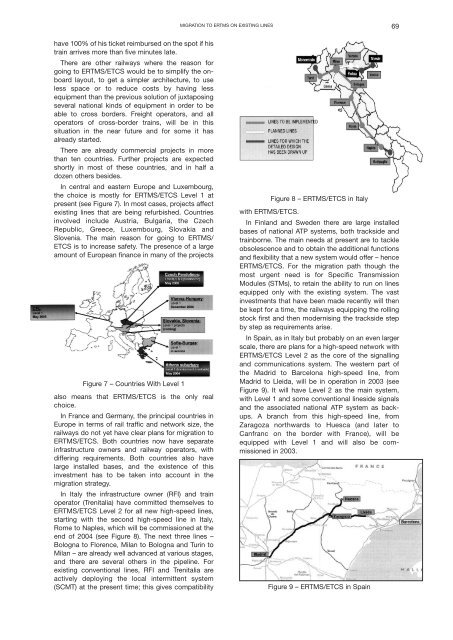Proceedings 2002/2003 - IRSE
Proceedings 2002/2003 - IRSE
Proceedings 2002/2003 - IRSE
Create successful ePaper yourself
Turn your PDF publications into a flip-book with our unique Google optimized e-Paper software.
MIGRATION TO ERTMS ON EXISTING LINES 69<br />
have 100% of his ticket reimbursed on the spot if his<br />
train arrives more than five minutes late.<br />
There are other railways where the reason for<br />
going to ERTMS/ETCS would be to simplify the onboard<br />
layout, to get a simpler architecture, to use<br />
less space or to reduce costs by having less<br />
equipment than the previous solution of juxtaposing<br />
several national kinds of equipment in order to be<br />
able to cross borders. Freight operators, and all<br />
operators of cross-border trains, will be in this<br />
situation in the near future and for some it has<br />
already started.<br />
There are already commercial projects in more<br />
than ten countries. Further projects are expected<br />
shortly in most of these countries, and in half a<br />
dozen others besides.<br />
In central and eastern Europe and Luxembourg,<br />
the choice is mostly for ERTMS/ETCS Level 1 at<br />
present (see Figure 7). In most cases, projects affect<br />
existing lines that are being refurbished. Countries<br />
involved include Austria, Bulgaria, the Czech<br />
Republic, Greece, Luxembourg, Slovakia and<br />
Slovenia. The main reason for going to ERTMS/<br />
ETCS is to increase safety. The presence of a large<br />
amount of European finance in many of the projects<br />
Figure 7 – Countries With Level 1<br />
also means that ERTMS/ETCS is the only real<br />
choice.<br />
In France and Germany, the principal countries in<br />
Europe in terms of rail traffic and network size, the<br />
railways do not yet have clear plans for migration to<br />
ERTMS/ETCS. Both countries now have separate<br />
infrastructure owners and railway operators, with<br />
differing requirements. Both countries also have<br />
large installed bases, and the existence of this<br />
investment has to be taken into account in the<br />
migration strategy.<br />
In Italy the infrastructure owner (RFI) and train<br />
operator (Trenitalia) have committed themselves to<br />
ERTMS/ETCS Level 2 for all new high-speed lines,<br />
starting with the second high-speed line in Italy,<br />
Rome to Naples, which will be commissioned at the<br />
end of 2004 (see Figure 8). The next three lines –<br />
Bologna to Florence, Milan to Bologna and Turin to<br />
Milan – are already well advanced at various stages,<br />
and there are several others in the pipeline. For<br />
existing conventional lines, RFI and Trenitalia are<br />
actively deploying the local intermittent system<br />
(SCMT) at the present time; this gives compatibility<br />
Figure 8 – ERTMS/ETCS in Italy<br />
with ERTMS/ETCS.<br />
In Finland and Sweden there are large installed<br />
bases of national ATP systems, both trackside and<br />
trainborne. The main needs at present are to tackle<br />
obsolescence and to obtain the additional functions<br />
and flexibility that a new system would offer – hence<br />
ERTMS/ETCS. For the migration path though the<br />
most urgent need is for Specific Transmission<br />
Modules (STMs), to retain the ability to run on lines<br />
equipped only with the existing system. The vast<br />
investments that have been made recently will then<br />
be kept for a time, the railways equipping the rolling<br />
stock first and then modernising the trackside step<br />
by step as requirements arise.<br />
In Spain, as in Italy but probably on an even larger<br />
scale, there are plans for a high-speed network with<br />
ERTMS/ETCS Level 2 as the core of the signalling<br />
and communications system. The western part of<br />
the Madrid to Barcelona high-speed line, from<br />
Madrid to Lleida, will be in operation in <strong>2003</strong> (see<br />
Figure 9). It will have Level 2 as the main system,<br />
with Level 1 and some conventional lineside signals<br />
and the associated national ATP system as backups.<br />
A branch from this high-speed line, from<br />
Zaragoza northwards to Huesca (and later to<br />
Canfranc on the border with France), will be<br />
equipped with Level 1 and will also be commissioned<br />
in <strong>2003</strong>.<br />
Figure 9 – ERTMS/ETCS in Spain

















